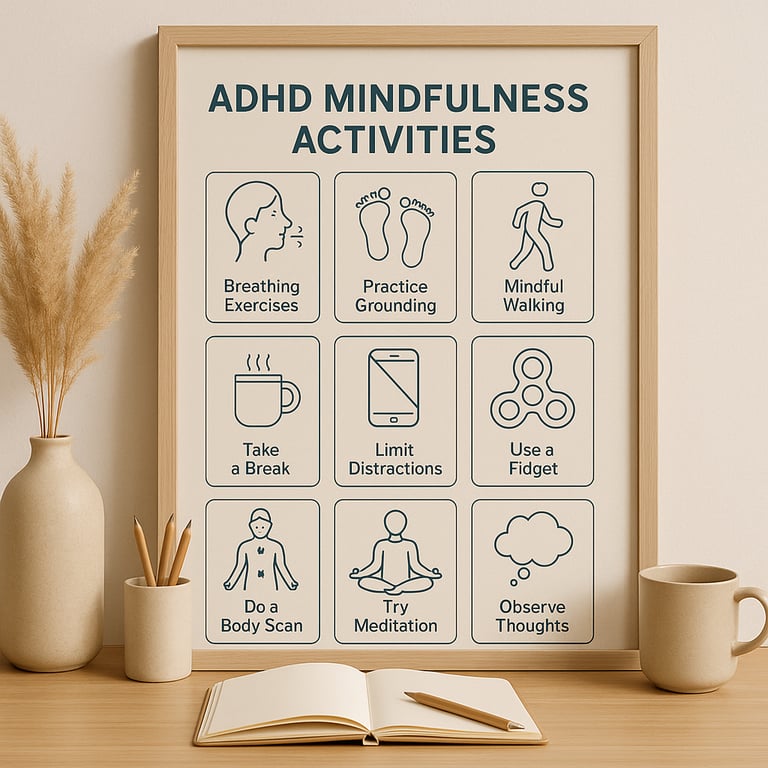Mindfulness Practices for ADHD: Simple Ways to Find Calm
8/8/20258 min read


Mindfulness Practices for ADHD: Simple Ways to Find Calm
Mindfulness isn't about emptying your mind or sitting still for hours. Instead, it's about developing awareness of your experiences without judgment—a skill that can help manage the core symptoms of ADHD, including inattention, impulsivity, and emotional dysregulation.
Living with ADHD often means navigating a constant whirlwind of thoughts, emotions, and sensations. The very idea of slowing down to be "mindful" might seem contradictory to how the ADHD brain works. Yet research increasingly shows that mindfulness—the practice of paying attention to the present moment with curiosity and acceptance—can be particularly beneficial for those with attention challenges.
In this guide, you'll discover why mindfulness works for the ADHD brain, practical techniques tailored for attention difficulties, strategies to build sustainable mindfulness habits, and the research-backed benefits you can expect with regular practice.
Understanding mindfulness and ADHD
ADHD presents unique challenges around focus, hyperactivity, impulsivity, and emotional regulation. While medication and behavioral strategies remain foundational treatments, they don't always address all symptoms—particularly the emotional and self-regulatory aspects of ADHD.
Mindfulness approaches ADHD from a different angle. Rather than trying to "fix" attention, mindfulness practices train awareness of where attention is at any given moment, creating the mental space to redirect it intentionally.
Neuroscience research highlights several mechanisms that make mindfulness particularly relevant for the ADHD brain:
Strengthening the attention "muscles" through repeated practice of noticing when the mind wanders
Decreasing hyperactivity in the default mode network—the brain region responsible for mind-wandering
Enhancing emotional regulation through improved awareness of feelings before they escalate
Supporting dopamine and reward pathways that are often disrupted in ADHD
Dr. Lidia Zylowska, a psychiatrist who developed the Mindful Awareness Practices (MAPs) program specifically for ADHD, has found that tailored mindfulness approaches can significantly improve attention, reduce hyperactivity, and help manage emotional reactivity.
Why ADHD brains struggle with standard mindfulness (barriers & opportunities)
Standard mindfulness instructions often involve sitting still and focusing on one thing for extended periods—precisely what challenges the ADHD brain most. Common obstacles include:
Restlessness and physical discomfort during still meditation
Frustration with mind-wandering, which happens more frequently with ADHD
Difficulty maintaining consistent practice
Sensory sensitivities that make certain meditation environments challenging
However, these very challenges present opportunities. The ADHD brain's heightened awareness of surroundings, tendency toward novelty-seeking, and capacity for hyperfocus can become strengths in mindfulness practice when properly channeled. The key is adapting mindfulness techniques to work with—rather than against—the ADHD brain.
Proven mindfulness practices for ADHD brains
The following exercises have been specifically adapted to accommodate the ADHD experience, making mindfulness more accessible and beneficial for attention-challenged brains.
1. Three-minute breathing space
How to practice:
First minute: Become aware of thoughts, feelings, and bodily sensations without trying to change anything
Second minute: Gently focus attention on breathing, noticing each inhale and exhale
Third minute: Expand awareness to include your whole body and surroundings
ADHD adaptation: Set a timer with a gentle sound. If sitting still is difficult, try this while standing or even walking slowly. The brevity makes this practice especially ADHD-friendly.
2. Walking meditation
Walking meditation harnesses physical movement—often craved by ADHD brains—as an anchor for attention.


How to practice:
Find a quiet space where you can walk back and forth (indoors or outdoors)
Walk at a comfortable pace, slightly slower than normal
Notice the sensations in your feet as they contact the ground
When your mind wanders, gently return attention to the walking sensations
ADHD adaptation: Vary the pace to keep engagement. Try counting steps or synchronizing breath with movement. This works well for hyperactive or combined ADHD types who benefit from incorporating movement.
3. Mindful labeling for emotional regulation
Many with attention differences struggle with emotional dysregulation. This practice helps identify emotions before they become overwhelming.
How to practice:
When you notice an emotional reaction arising, pause
Label the emotion simply: "anxiety," "frustration," "excitement"
Notice where you feel the emotion in your body
Take three conscious breaths while acknowledging the emotion
ADHD adaptation: Create a feelings vocabulary list or emotional scale (1-10) if identifying emotions is difficult. Practice this briefly multiple times daily rather than in one extended session.
4. Mindful activities
Incorporating mindfulness into enjoyable activities can help bypass resistance to formal meditation.


Examples include:
Mindful cooking: Fully engage with colors, smells, textures, and tastes
Art or coloring: Focus completely on the colors, lines, and creative process
Gardening: Notice the sensations of soil, plants, and outdoor environment
Playing or listening to music: Immerse yourself in the sounds and rhythms
ADHD adaptation: Choose activities that naturally engage your attention or tap into hyperfocus. Set a timer if you tend to lose track of time.
How to practice:
Set random reminders on your phone 3-5 times daily
When the reminder sounds, pause for 30 seconds
Take three conscious breaths
Notice: Where is my attention right now? What am I feeling? What sensations are in my body?
ADHD adaptation: Link check-ins to existing habits (after using the bathroom, before checking email, when stopping at red lights) to build consistency.


5. Mini mindfulness check-ins
Brief moments of awareness scattered throughout the day can be more effective for ADHD brains than single longer sessions.


This brief practice creates a pause in your day to reset attention and connect with the present moment.
Making mindfulness stick: ADHD-friendly habits for daily calm
Consistency with mindfulness can be particularly challenging for those with attention differences. These strategies help overcome common obstacles to establishing a sustainable practice.
The ADHD brain often struggles with internal time management and remembering new habits. Combat this by:
Setting phone alarms or using mindfulness apps with notifications
Placing visual reminders (sticky notes, small objects) in frequently seen locations
Creating calendar appointments for practice sessions
Using technology specifically designed for attention challenges, like interval timers
External cues and reminders
Building social accountability
External accountability dramatically increases success rates for establishing new habits:
Find a "mindfulness buddy" to check in with regularly
Join an ADHD-friendly meditation group (in-person or virtual)
Share your practice intentions with someone who will follow up
Consider working with an ADHD coach who understands mindfulness
Starting small and scaling gradually
Ambitious goals often lead to abandonment. Instead:
Begin with just 1-2 minutes of practice daily
Increase duration by 30 seconds each week
Celebrate consistency over duration—five days of 2-minute sessions is better than one 10-minute session
Track your progress visually to build momentum
Integrating mindfulness into existing routines
Rather than adding something new, enhance what you already do:
Practice mindful awareness during morning coffee or tea
Do a body scan while waiting for your computer to start
Use commute time for breathing awareness (if not driving)
Turn hand-washing into a brief mindfulness moment
Practicing self-compassion for setbacks
Self-criticism after missed practice can create a negative cycle. Instead:
Acknowledge that inconsistency is part of the ADHD experience, not a personal failing
Use the "fresh start" approach—each moment offers a new beginning
Replace "should" statements with kind self-talk
Treat yourself with the same understanding you would offer a friend
The benefits of mindfulness for ADHD: what research and real people say
Mindfulness offers multiple evidence-backed benefits specifically relevant to ADHD challenges. Here's what research and personal experiences reveal:
Improved attention and focus
Studies, including those from UCLA's Mindful Awareness Research Center, show that regular mindfulness practice helps strengthen sustained attention and reduce distractibility. Participants report improved ability to stay on task and notice when their mind has wandered—a crucial skill for ADHD management.
Jake, a software developer with ADHD, shares: "Before mindfulness, I wouldn't even notice I'd gotten off track until 30 minutes had passed. Now I catch myself within seconds and can redirect without the self-criticism that used to follow."
Reduced impulsivity
Mindfulness creates a pause between stimulus and response—what psychologists call the "space between"—allowing for more conscious choices rather than automatic reactions.
Research from Mindfulness-Based Cognitive Therapy (MBCT) for ADHD shows significant reductions in impulsive decision-making after 8 weeks of regular practice. Participants report greater ability to pause before speaking or acting, resulting in fewer regrettable impulsive behaviors.
Enhanced emotional regulation
Emotional dysregulation—experiencing emotions more intensely and having difficulty managing them—affects many with ADHD. Mindfulness helps by:
Increasing awareness of emotional triggers
Providing techniques to stay grounded during emotional activation
Teaching non-judgmental observation of feelings without immediate reaction
Studies show reduced emotional reactivity and lower reported stress levels among ADHD participants after mindfulness training. Many practitioners describe developing a "responsive rather than reactive" relationship with their emotions.
Greater self-awareness and metacognition
Mindfulness develops metacognition—awareness of one's own thought processes—which is often challenging with ADHD. This improved self-awareness helps identify patterns, strengths, and triggers.
Sarah, a teacher with ADHD, notes: "Mindfulness helped me recognize that my attention isn't 'broken'—it just works differently. I can now identify my optimal focus times and environments instead of fighting against my brain."
Reduced ADHD-related stress and anxiety
Living with ADHD often means dealing with chronic stress from missed deadlines, social misunderstandings, and organizational challenges. Research shows mindfulness practice significantly reduces overall stress levels and the secondary anxiety that frequently accompanies ADHD.
Regular practitioners report feeling more at peace with their ADHD traits and less overwhelmed by daily challenges. This stress reduction creates a positive feedback loop, as lower stress levels themselves improve attention and cognitive function.
Improved self-acceptance
Perhaps the most profound benefit reported by many with ADHD is increased self-compassion and reduced shame. Mindfulness practices emphasize non-judgmental awareness, which can transform the negative self-concept many develop after years of ADHD-related setbacks.
Michael, a business consultant diagnosed with ADHD in adulthood, shares: "Mindfulness helped me separate who I am from my symptoms. I've stopped the constant self-criticism and learned to work with my brain instead of against it."
Conclusion
Mindfulness offers a powerful complementary approach to managing ADHD symptoms and enhancing overall wellbeing. By adapting traditional practices to accommodate attention differences, those with ADHD can harness the benefits of present-moment awareness without the frustration that standard meditation sometimes causes.
Remember that mindfulness is a skill developed gradually over time. Start with brief, movement-friendly practices, build in external supports, and approach the process with self-compassion. Even small moments of mindfulness scattered throughout your day can create meaningful changes in attention, emotional regulation, and self-awareness.
The journey of mindfulness with ADHD isn't about achieving perfect attention or stillness—it's about developing a kinder, more aware relationship with your unique brain. Begin today with just one minute of conscious breathing, and build from there.
Frequently asked questions
Can mindfulness really help reduce ADHD symptoms?
Yes, evidence suggests that mindfulness can improve attention, decrease impulsivity, and help manage emotional ups and downs in people with ADHD. Results will vary, but benefits often increase with regular practice.
What are the best mindfulness practices for someone with ADHD?
Short, movement-friendly mindfulness (like walking meditation), brief breathwork, and integrating mindfulness into everyday activities work well. The key is to adapt practices to fit your attention style.
Do I need to meditate for a long time to see results?
No—starting with even 3–5 minutes per day can help. Consistency is more important than duration for ADHD brains.
How do I stay motivated to practice mindfulness with ADHD?
External reminders, social support ("mindfulness buddy"), joining a class, and practicing self-compassion are all important for building sustainable habits.
Should I replace ADHD medication with mindfulness?
Mindfulness is best used as a complementary tool, not a replacement for medical treatment. Always consult with a healthcare provider about medication changes.
© 2025. MindPop. Built with ❤️ for ADHD brains everywhere.
Ready to Transform Your ADHD Productivity?
Join a community of ADHD minds and finally get things done.